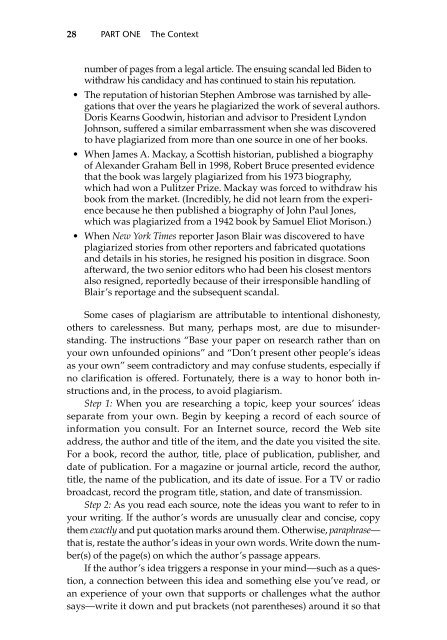Beyond Feelings
Beyond Feelings
Beyond Feelings
You also want an ePaper? Increase the reach of your titles
YUMPU automatically turns print PDFs into web optimized ePapers that Google loves.
28 PART ONE The Context<br />
number of pages from a legal article. The ensuing scandal led Biden to<br />
withdraw his candidacy and has continued to stain his reputation.<br />
• The reputation of historian Stephen Ambrose was tarnished by allegations<br />
that over the years he plagiarized the work of several authors.<br />
Doris Kearns Goodwin, historian and advisor to President Lyndon<br />
Johnson, suffered a similar embarrassment when she was discovered<br />
to have plagiarized from more than one source in one of her books.<br />
• When James A. Mackay, a Scottish historian, published a biography<br />
of Alexander Graham Bell in 1998, Robert Bruce presented evidence<br />
that the book was largely plagiarized from his 1973 biography,<br />
which had won a Pulitzer Prize. Mackay was forced to withdraw his<br />
book from the market. (Incredibly, he did not learn from the experience<br />
because he then published a biography of John Paul Jones,<br />
which was plagiarized from a 1942 book by Samuel Eliot Morison.)<br />
• When New York Times reporter Jason Blair was discovered to have<br />
plagiarized stories from other reporters and fabricated quotations<br />
and details in his stories, he resigned his position in disgrace. Soon<br />
afterward, the two senior editors who had been his closest mentors<br />
also resigned, reportedly because of their irresponsible handling of<br />
Blair’s reportage and the subsequent scandal.<br />
Some cases of plagiarism are attributable to intentional dishonesty,<br />
others to carelessness. But many, perhaps most, are due to misunderstanding.<br />
The instructions “Base your paper on research rather than on<br />
your own unfounded opinions” and “Don’t present other people’s ideas<br />
as your own” seem contradictory and may confuse students, especially if<br />
no clarification is offered. Fortunately, there is a way to honor both instructions<br />
and, in the process, to avoid plagiarism.<br />
Step 1: When you are researching a topic, keep your sources’ ideas<br />
separate from your own. Begin by keeping a record of each source of<br />
information you consult. For an Internet source, record the Web site<br />
address, the author and title of the item, and the date you visited the site.<br />
For a book, record the author, title, place of publication, publisher, and<br />
date of publication. For a magazine or journal article, record the author,<br />
title, the name of the publication, and its date of issue. For a TV or radio<br />
broadcast, record the program title, station, and date of transmission.<br />
Step 2: As you read each source, note the ideas you want to refer to in<br />
your writing. If the author’s words are unusually clear and concise, copy<br />
them exactly and put quotation marks around them. Otherwise, paraphrase—<br />
that is, restate the author’s ideas in your own words. Write down the number(s)<br />
of the page(s) on which the author’s passage appears.<br />
If the author’s idea triggers a response in your mind—such as a question,<br />
a connection between this idea and something else you’ve read, or<br />
an experience of your own that supports or challenges what the author<br />
says—write it down and put brackets (not parentheses) around it so that


